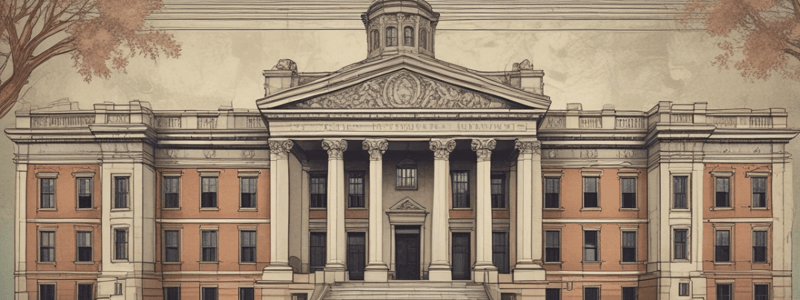Podcast
Questions and Answers
What factors contributed to the expansion of juvenile court dockets?
What factors contributed to the expansion of juvenile court dockets?
- Decreased federal government involvement and state reformation
- Increased focus on punishment rather than rehabilitation
- Stronger federal government role, state reformation, and US Supreme Court decisions (correct)
- Lack of resources for community-based interventions
When was the first established federal grant-making law for juvenile justice?
When was the first established federal grant-making law for juvenile justice?
- 1964
- 1974 (correct)
- 1984
- 1994
What shift did states make in their approach to juvenile correctional facilities?
What shift did states make in their approach to juvenile correctional facilities?
- They increased the number of large-scale facilities.
- They decreased the number of community-based environments.
- They shifted from large-scale correctional facilities toward smaller, community-based environments. (correct)
- They eliminated juvenile correctional facilities altogether.
What was the focus of juvenile court reform in the present day?
What was the focus of juvenile court reform in the present day?
What was the approach to dealing with youthful offenders in the 1990s?
What was the approach to dealing with youthful offenders in the 1990s?
What was the public and policy makers' response to the growing crime problem in the youthful offender population?
What was the public and policy makers' response to the growing crime problem in the youthful offender population?
What types of issues were included in the expanded juvenile court dockets?
What types of issues were included in the expanded juvenile court dockets?
What was the result of the increased focus on due process protection rights?
What was the result of the increased focus on due process protection rights?
Was the growing crime problem in the youthful offender population a long-term issue?
Was the growing crime problem in the youthful offender population a long-term issue?
What was the focus of the juvenile court reform in the 1990s?
What was the focus of the juvenile court reform in the 1990s?
Flashcards are hidden until you start studying
Study Notes
- Juvenile court dockets expanded to include minor offenses, truancy issues, and child welfare concerns.
- Changes driven by stronger federal government role, state reformation, and US Supreme Court decisions.
- First established federal grant-making law was the Juvenile Justice and Delinquency Prevention Act of 1974.
- States shifted from large-scale correctional facilities toward smaller, community-based environments.
- Increased focus on due process protection rights.
- The 1990s saw a tough on crime approach to dealing with youthful offenders.
- Growing crime problem in the youthful offender population was short-lived.
- Public reaction, media coverage, and policy makers' responses were disproportionate to what was happening.
- Today's juvenile court reform focuses on preventative and diversionary interventions.
- Expansion in due process protections for juvenile offenders.
Studying That Suits You
Use AI to generate personalized quizzes and flashcards to suit your learning preferences.




